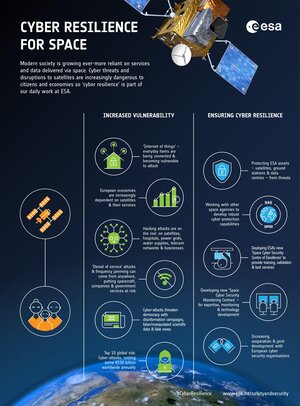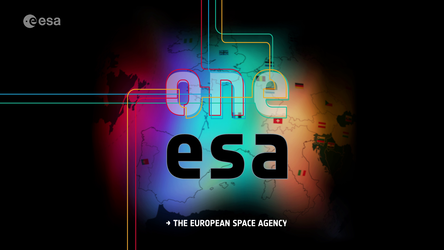Accept all cookies Accept only essential cookies See our Cookie Notice

About ESA
The European Space Agency (ESA) is Europe’s gateway to space. Its mission is to shape the development of Europe’s space capability and ensure that investment in space continues to deliver benefits to the citizens of Europe and the world.
Highlights
ESA - United space in Europe
This is ESA ESA facts Member States & Cooperating States Funding Director General Top management For Member State Delegations European vision European Space Policy ESA & EU Space Councils Responsibility & Sustainability Annual Report Calendar of meetings Corporate newsEstablishments & sites
ESA Headquarters ESA ESTEC ESA ESOC ESA ESRIN ESA EAC ESA ESAC Europe's Spaceport ESA ESEC ESA ECSAT Brussels Office Washington OfficeWorking with ESA
Business with ESA ESA Commercialisation Gateway Law at ESA Careers Cyber resilience at ESA IT at ESA Newsroom Partnerships Merchandising Licence Education Open Space Innovation Platform Integrity and Reporting Administrative Tribunal Health and SafetyMore about ESA
History ESA Historical Archives Exhibitions Publications Art & Culture ESA Merchandise Kids Diversity ESA Brand Centre ESA ChampionsLatest
Space in Member States
Find out more about space activities in our 23 Member States, and understand how ESA works together with their national agencies, institutions and organisations.
Science & Exploration
Exploring our Solar System and unlocking the secrets of the Universe
Go to topicAstronauts
Missions
Juice Euclid Webb Solar Orbiter BepiColombo Gaia ExoMars Cheops Exoplanet missions More missionsActivities
International Space Station Orion service module Gateway Concordia Caves & Pangaea BenefitsSpace Safety
Protecting life and infrastructure on Earth and in orbit
Go to topicAsteroids
Asteroids and Planetary Defence Asteroid danger explained Flyeye telescope: asteroid detection Hera mission: asteroid deflection Near-Earth Object Coordination CentreSpace junk
About space debris Space debris by the numbers Space Environment Report In space refuelling, refurbishing and removingSafety from space
Clean Space ecodesign Zero Debris Technologies Space for Earth Supporting Sustainable DevelopmentLatest
Applications
Using space to benefit citizens and meet future challenges on Earth
Go to topicObserving the Earth
Observing the Earth Future EO Copernicus Meteorology Space for our climate Satellite missionsCommercialisation
ESA Commercialisation Gateway Open Space Innovation Platform Business Incubation ESA Space SolutionsLatest
Enabling & Support
Making space accessible and developing the technologies for the future
Go to topicBuilding missions
Space Engineering and Technology Test centre Laboratories Concurrent Design Facility Preparing for the future Shaping the Future Discovery and Preparation Advanced Concepts TeamSpace transportation
Space Transportation Ariane Vega Space Rider Future space transportation Boost! Europe's Spaceport Launches from Europe's Spaceport from 2012Latest

Space for Europe
Thank you for liking
You have already liked this page, you can only like it once!
Space is an essential ingredient in Europe’s future. The European Union, EU, and European Space Agency, ESA, are coming together to make that future happen: separate organisations with differing ranges of competences, Member States and governing rules and procedures, but increasingly converging their efforts along common objectives – to put space at the service of European policies, citizens and industry.
ESA is an international organisation with 22 Member States. By coordinating the financial and intellectual resources of its members, it can undertake programmes and activities far beyond the scope of any single European country, and can harness its decades of experience to implement the continent’s most ambitious new space efforts. The EU is a supranational union of European states, possessing the sovereignty to set Europe’s space ambitions, with a dedicated arm – the EU Agency for the Space Programme, EUSPA – to provide reliable, safe and secure space-related services, maximising their socio-economic benefits for European society and business.
The EU and ESA together have already proved a formidable partnership, between them establishing flagship European space programmes: Copernicus, the world’s biggest Earth observation initiative; Galileo, the world’s most precise satellite navigation system; and EGNOS, a space-based augmentation system making European satellite navigation sufficiently reliable for aircraft and other safety-of-life users. Coming next: IRIS², Europe's new Infrastructure for Resilience, Interconnectivity & Security by Satellites.This new satellite constellation will offer enhanced communication capacities to governmental users and businesses, constituting a new space-based pillar for a digital, resilient and safer Europe to foster European competitiveness and societal progress – plus other flagship activities on the way, focused on both the space sector ‘upstream’ – the missions and infrastructure that go into space – and ‘downstream’ – the data and services that return down to Earth.
-
CREDIT
ESA -
LICENCE
ESA Standard Licence

Cyber resilience for space

CM22 - Delegation from the European Commission

Accelerate the use of Space in Europe

Welcome to the universe of ESA















 Germany
Germany
 Austria
Austria
 Belgium
Belgium
 Denmark
Denmark
 Spain
Spain
 Estonia
Estonia
 Finland
Finland
 France
France
 Greece
Greece
 Hungary
Hungary
 Ireland
Ireland
 Italy
Italy
 Luxembourg
Luxembourg
 Norway
Norway
 The Netherlands
The Netherlands
 Poland
Poland
 Portugal
Portugal
 Czechia
Czechia
 Romania
Romania
 United Kingdom
United Kingdom
 Slovenia
Slovenia
 Sweden
Sweden
 Switzerland
Switzerland

























